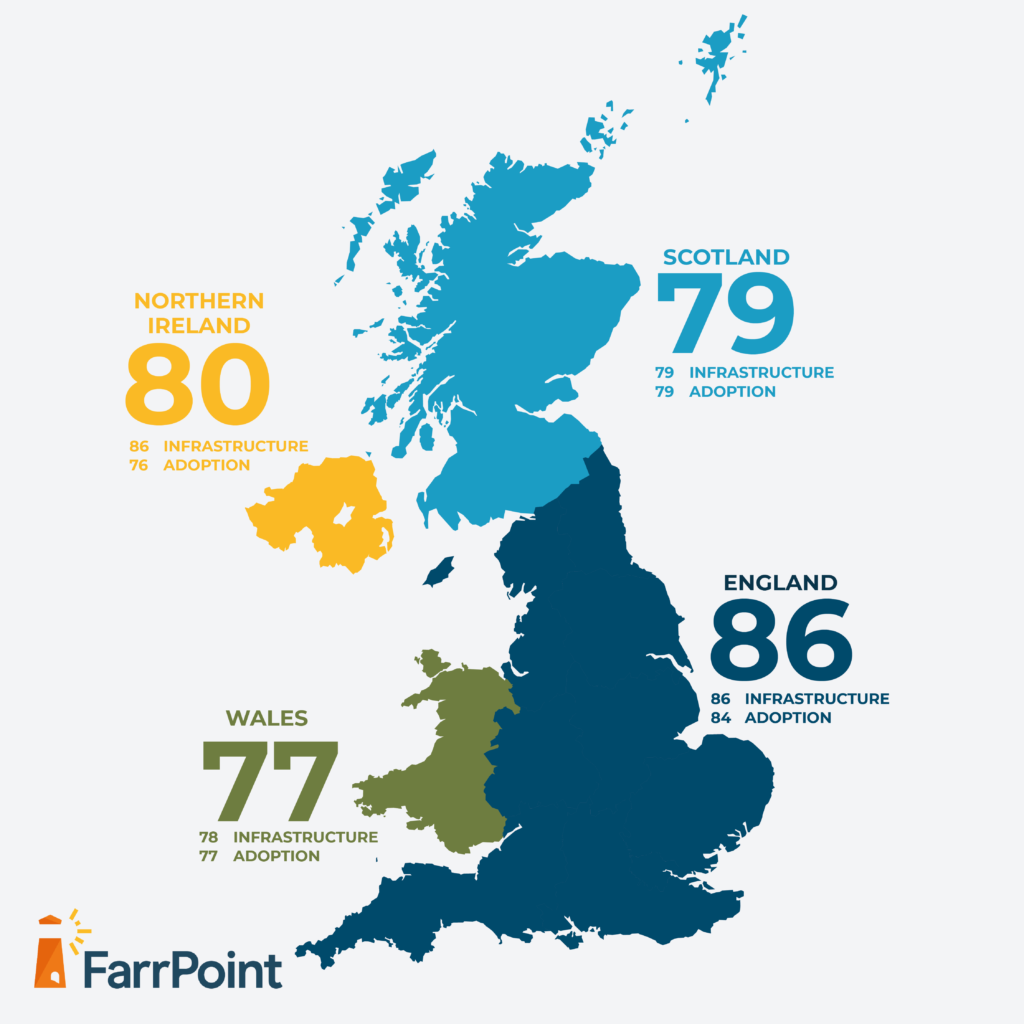ENGLAND has been named as the most-prepared home nation for digital readiness according to its new benchmarking framework.
The Digital Connectivity Readiness Index (DCRI) supports UK policy makers and digital leaders in enhancing their digital connectivity strategies by scoring a range of infrastructure and digital adoption metrics to identify gaps and opportunities.
England topped the scoring out of the home nations with a score of 86 out of a possible 100, followed by Northern Ireland, Scotland and Wales with scores of 80, 79 and 77 respectively.

FarrPoint is currently working with several local authorities across the UK to define their DCRI scores, which will then be used to track and benchmark their progress over time.
The UK as a whole has an average DCRI score of 84, with an infrastructure sub-score of 87 showing the effectiveness of the UK Government’s prioritisation of investment in improving digital network infrastructure.
On adoption, the UK scores 83 suggesting there is more to be done.
The scores contained within the DCRI are based on key indicators gathered from a series of data sources, including Ofcom and the Office for National Statistics.
A robust approach to weighting has been used to ensure that the indicators take into account the commercial, regulatory and policy prioritisation considerations.
This delivers a result that is not only accurate but also helps deliver real value when it comes to designing digital? connectivity infrastructure, adoption and inclusion?projects.
Looking beyond the headline scores, there are a range of differences in performance between the four nations on infrastructure and adoption.
England performs well on both infrastructure (89) and adoption (84), driven by a strong roll out of digital networks and a vibrant digital economy. However, challenges remain around security and wellbeing online, which are key challenges for adoption.
Scotland’s lower score for infrastructure (79) reflects some of the key challenges in rolling out networks across rural regions, such as the Highlands and Islands.
On adoption (79), whilst Scotland scores well on household adoption including the use of online public services, it performs less well on digital economy and innovation indicators.
Northern Ireland’s DCRI results paint a particularly interesting picture, with a significant difference in performance on infrastructure (86) and adoption (76).
On one hand, Project Stratum has seen significant improvements made to the network infrastructure.
However, indicators around the digital sector, innovation and getting households online are below that of the rest of the UK.
Wales’ performance is broadly similar across the infrastructure (78) and adoption (77) indexes.
While the country performed well on 4G and superfast connectivity, roll-out of Gigabit and 5G networks are both below the UK average.
On the adoption side, challenges around security, wellbeing and skills, as well as a less vibrant digital economy means its score is lower than the UK average.
Matthew Izatt-Lowry, Senior Economist at FarrPoint, said: “Digital connectivity is increasingly important in enabling economic, social and environmental change.
“We understand how vital it is for local decision makers to take an evidence-based approach to understand their key challenges and opportunities.
“That’s why we have created the Digital Connectivity Readiness Index as a tool to enable the sector to make the best possible decisions.
“It’s important for decision makers to have this kind of information when developing digital strategies and prioritising projects to maximise impact and benefits for their region.
“As can be seen from the results of this initial DCRI analysis, the UK and its constituent nations perform well on many of the infrastructure indicators.
“However, infrastructure alone, without adoption, will not produce any benefits for households, communities or businesses meaning there is still a lot of opportunity to improve the country-wide adoption of the technology.
“The next stage for local decision makers is to find out how their region scores, which will allow them to better understand where the key opportunities are for harnessing the full potential of digital.”
The full report is available to download here.
The next FarrPoint Digital Connectivity Readiness Index results will be released in early 2024.

